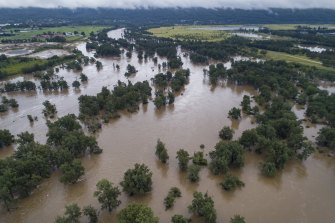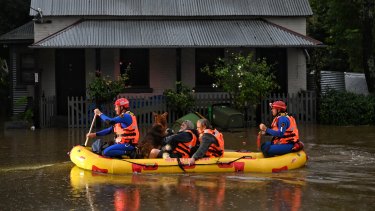Billions of dollars of housing development across NSW will be put on the line and councils will be forced to consider flood evacuation routes under new state government planning powers for floodplains.
The government has given councils the power to refuse development occurring on land above the previously prescribed one-in-100 year floodline, which could stymie swathes of western Sydney from further housing supply following this year’s devastating and deadly floods.
In the flood zone, Penrith.Credit:Sydney Morning Herald
The new planning instruments will also force councils to consider flood evacuation routes and climate change factors when weighing up development opportunities.
That puts into question the future Marsden Park North and West Schofields, two new suburbs the government halted the rezoning of due to concerns about escape. While they are being led by state planners, the government’s own policies are likely to conform.
NSW Planning Minister Rob Stokes - who in March revealed he had paused progress on thousands of homes in those two suburbs because of evacuation concerns - said the recent floods were a reminder of how crucial planning for resilience against major events had become.
“We support careful development of flood-prone land but that development needs to put community safety first - it’s about keeping people and property safe,” Mr Stokes said, with councils being given six weeks to amend their policies to allow for the changes.

A swollen Nepean River near Penrith during the March floods.Credit:Wolter Peeters
Councils have previously been prohibited from restricting development beyond the prescribed one-in-100-year (meaning 1 per cent chance of a large flood occurring in any given year) level, causing great angst about being able to deliver infrastructure that mitigates flood risk.
The new merit-based approach still identifies that level as an appropriate starting point.
Western Sydney University water engineering expert Ataur Rahman described that standard as “quite insufficient” and the threshold for development should be raised to the probable maximum flood (PMF), the most severe conditions expected.
“In Sydney the big problem is we have very limited land but that doesn’t mean we should build in areas that have significant flood risk,” Professor Rahman said.

SES teams rescue Windsor residents from their homes during the floods earlier this year.Credit:Nick Moir
Former NSW State Emergency Service deputy director general Chas Keys said the “purist” in him agreed the development level should be the PMF, but the difference between the one 1 per cent level and the PMF in the Hawkesbury-Nepean Valley would in some areas be several metres.
“You will effectively sterilise land from residential use. The more you change that line the more land you lose,” Dr Keys said.
The changes are expected to be welcomed by Australia’s largest insurer, IAG, which last year wrote a submission strongly in favour of giving councils the ability to raise development controls above the 1 per cent level.
But the news was received cautiously by Penrith Council, which has been calling for the installation of the $1.8 billion Castlereagh Connection as a major flood evacuation route for western Sydney residents - identified as high priority by Infrastructure Australia.

Planning Minister Rob Stokes said development on flood-prone land needs to put community safety first.Credit:Louise Kennerley
Penrith mayor Karen McKeown said she always welcomed planning changes that allowed councils to have “power over their own destiny”, however she remained sceptical, as “the devil’s in the detail”.
As part of the regulatory overhaul development should be refused if it affects the “safe occupation and efficient evacuation of people”, or if it exceeds the capacity of existing evacuation routes for the
surrounding area in the event of a flood.
Cr McKeown said the lack of information surrounding flood evacuation capacity would make it difficult for the council to satisfy that requirement.
Her response follows a submission from Penrith to the Department of Planning, Infrastructure and Environment last year in which the council warned raising the development controls above the 1 per cent level could potentially create an impediment to growing the western metropolis.
Blacktown mayor Tony Bleasdale, whose municipality was affected by the floods and who has long advocated for infrastructure to keep up with the rate of residential development, labelled the increased powers as a “Catch 22”.
“Is it simply a case where state governments are shifting liability?” he said.
Stephen McMahon, NSW president of property industry group the Urban Development Industry of Australia described the new approach as “overtly heavy-handed” and would have a huge potential impact on business and housing supply. He said the “very sensible” one-in-100 approach should continue.
“In the north-west growth area, the new flood planning package will create an overly cautious approach which will further undermine the supply of homes, jobs and economic development,” he said.
“We urge the government to hurry up and make a decision on how it is going to manage the flooding and evacuation issues and not kick the can down the road.”
Note from the Editor
Herald editor Lisa Davies writes an exclusive newsletter for subscribers on the week’s most important stories and issues. Sign up here to receive it every Friday.
Angus Thompson is an Urban Affairs reporter for The Sydney Morning Herald.
Most Viewed in National
https://news.google.com/__i/rss/rd/articles/CBMijQFodHRwczovL3d3dy5zbWguY29tLmF1L25hdGlvbmFsL3lvdS13aWxsLXN0ZXJpbGlzZS1sYW5kLWZyb20tcmVzaWRlbnRpYWwtdXNlLW5ldy1wb3dlcnMtdG8tcmVmdXNlLWZsb29kcGxhaW4tZGV2ZWxvcG1lbnQtMjAyMTA1MjgtcDU3dzM2Lmh0bWzSAY0BaHR0cHM6Ly9hbXAuc21oLmNvbS5hdS9uYXRpb25hbC95b3Utd2lsbC1zdGVyaWxpc2UtbGFuZC1mcm9tLXJlc2lkZW50aWFsLXVzZS1uZXctcG93ZXJzLXRvLXJlZnVzZS1mbG9vZHBsYWluLWRldmVsb3BtZW50LTIwMjEwNTI4LXA1N3czNi5odG1s?oc=5
2021-05-28 19:00:00Z
CBMijQFodHRwczovL3d3dy5zbWguY29tLmF1L25hdGlvbmFsL3lvdS13aWxsLXN0ZXJpbGlzZS1sYW5kLWZyb20tcmVzaWRlbnRpYWwtdXNlLW5ldy1wb3dlcnMtdG8tcmVmdXNlLWZsb29kcGxhaW4tZGV2ZWxvcG1lbnQtMjAyMTA1MjgtcDU3dzM2Lmh0bWzSAY0BaHR0cHM6Ly9hbXAuc21oLmNvbS5hdS9uYXRpb25hbC95b3Utd2lsbC1zdGVyaWxpc2UtbGFuZC1mcm9tLXJlc2lkZW50aWFsLXVzZS1uZXctcG93ZXJzLXRvLXJlZnVzZS1mbG9vZHBsYWluLWRldmVsb3BtZW50LTIwMjEwNTI4LXA1N3czNi5odG1s
Bagikan Berita Ini














0 Response to "‘You will sterilise land from residential use’: New powers to refuse floodplain development - The Sydney Morning Herald"
Post a Comment